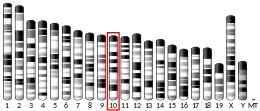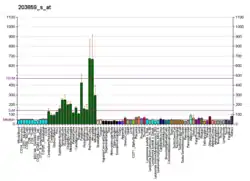PALM
Paralemmin is a protein that in humans is encoded by the PALM gene.[5][6][7]
This gene encodes a member of the paralemmin protein family. Other members of this family include CAP-23, GAP-43, MARCKS, and MacMARCKS. The product of this gene is a prenylated and palmitoylated phosphoprotein that associates with the cytoplasmic face of plasma membranes and is implicated in plasma membrane dynamics in neurons and other cell types.[5][6] Several alternatively spliced transcript variants have been identified, but the full-length nature of only two transcript variants has been determined.[7]
References
- GRCh38: Ensembl release 89: ENSG00000099864 - Ensembl, May 2017
- GRCm38: Ensembl release 89: ENSMUSG00000035863 - Ensembl, May 2017
- "Human PubMed Reference:". National Center for Biotechnology Information, U.S. National Library of Medicine.
- "Mouse PubMed Reference:". National Center for Biotechnology Information, U.S. National Library of Medicine.
- Burwinkel B, Miglierini G, Jenne DE, Gilbert DJ, Copeland NG, Jenkins NA, Ring HZ, Francke U, Kilimann MW (Aug 1998). "Structure of the human paralemmin gene (PALM), mapping to human chromosome 19p13.3 and mouse chromosome 10, and exclusion of coding mutations in grizzled, mocha, jittery, and hesitant mice". Genomics. 49 (3): 462–6. doi:10.1006/geno.1998.5276. PMID 9615234.
- Kutzleb C, Sanders G, Yamamoto R, Wang X, Lichte B, Petrasch-Parwez E, Kilimann MW (Dec 1998). "Paralemmin, a Prenyl-Palmitoyl–anchored Phosphoprotein Abundant in Neurons and Implicated in Plasma Membrane Dynamics and Cell Process Formation". J Cell Biol. 143 (3): 795–813. doi:10.1083/jcb.143.3.795. PMC 2148134. PMID 9813098.
- "Entrez Gene: PALM paralemmin".
Further reading
- Bonaldo MF, Lennon G, Soares MB (1997). "Normalization and subtraction: two approaches to facilitate gene discovery". Genome Res. 6 (9): 791–806. doi:10.1101/gr.6.9.791. PMID 8889548.
- Nagase T, Seki N, Ishikawa K, et al. (1997). "Prediction of the coding sequences of unidentified human genes. VI. The coding sequences of 80 new genes (KIAA0201-KIAA0280) deduced by analysis of cDNA clones from cell line KG-1 and brain". DNA Res. 3 (5): 321–9, 341–54. doi:10.1093/dnares/3.5.321. PMID 9039502.
- Strausberg RL, Feingold EA, Grouse LH, et al. (2003). "Generation and initial analysis of more than 15,000 full-length human and mouse cDNA sequences". Proc. Natl. Acad. Sci. U.S.A. 99 (26): 16899–903. Bibcode:2002PNAS...9916899M. doi:10.1073/pnas.242603899. PMC 139241. PMID 12477932.
- Ota T, Suzuki Y, Nishikawa T, et al. (2004). "Complete sequencing and characterization of 21,243 full-length human cDNAs". Nat. Genet. 36 (1): 40–5. doi:10.1038/ng1285. PMID 14702039.
- Gauthier-Campbell C, Bredt DS, Murphy TH, El-Husseini Ael-D (2005). "Regulation of Dendritic Branching and Filopodia Formation in Hippocampal Neurons by Specific Acylated Protein Motifs". Mol. Biol. Cell. 15 (5): 2205–17. doi:10.1091/mbc.E03-07-0493. PMC 404016. PMID 14978216.
- Grimwood J, Gordon LA, Olsen A, et al. (2004). "The DNA sequence and biology of human chromosome 19". Nature. 428 (6982): 529–35. Bibcode:2004Natur.428..529G. doi:10.1038/nature02399. PMID 15057824.
- Brandenberger R, Wei H, Zhang S, et al. (2005). "Transcriptome characterization elucidates signaling networks that control human ES cell growth and differentiation". Nat. Biotechnol. 22 (6): 707–16. doi:10.1038/nbt971. PMID 15146197. S2CID 27764390.
- Suzuki Y, Yamashita R, Shirota M, et al. (2004). "Sequence Comparison of Human and Mouse Genes Reveals a Homologous Block Structure in the Promoter Regions". Genome Res. 14 (9): 1711–8. doi:10.1101/gr.2435604. PMC 515316. PMID 15342556.
- Gerhard DS, Wagner L, Feingold EA, et al. (2004). "The Status, Quality, and Expansion of the NIH Full-Length cDNA Project: The Mammalian Gene Collection (MGC)". Genome Res. 14 (10B): 2121–7. doi:10.1101/gr.2596504. PMC 528928. PMID 15489334.
- Kimura K, Wakamatsu A, Suzuki Y, et al. (2006). "Diversification of transcriptional modulation: Large-scale identification and characterization of putative alternative promoters of human genes". Genome Res. 16 (1): 55–65. doi:10.1101/gr.4039406. PMC 1356129. PMID 16344560.
- Basile M, Lin R, Kabbani N, et al. (2006). "Paralemmin interacts with D3 dopamine receptors: implications for membrane localization and cAMP signaling". Arch. Biochem. Biophys. 446 (1): 60–8. doi:10.1016/j.abb.2005.10.027. PMID 16386234.
- Olsen JV, Blagoev B, Gnad F, et al. (2006). "Global, in vivo, and site-specific phosphorylation dynamics in signaling networks". Cell. 127 (3): 635–48. doi:10.1016/j.cell.2006.09.026. PMID 17081983. S2CID 7827573.
This article is issued from Wikipedia. The text is licensed under Creative Commons - Attribution - Sharealike. Additional terms may apply for the media files.




